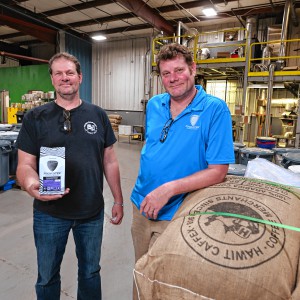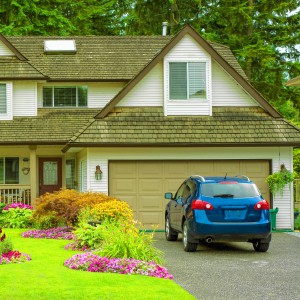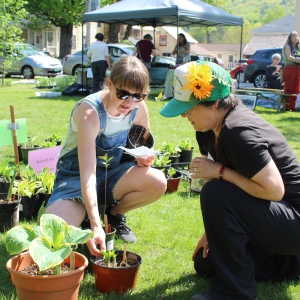Which way to Ripton? Shutesbury historical panel eyes preservation of iconic guideboard
| Published: 01-05-2023 7:51 PM |
SHUTESBURY — For nearly 200 years, a guideboard on the town common in Shutesbury has provided travelers with a sense of direction and their distance from communities both near and far.
Whether it be the 17 miles west to Northampton, the 40 miles north to Keene, New Hampshire, or the 75 miles east to Boston, or even the 6 miles east to Prescott, a historical town now under the Quabbin Reservoir, or, at times, the 27 miles to Ripton, a fictional town created as a joke in the 1980s and periodically painted on to the structure, the guideboard at the intersection of Wendell, Cooleyville and Leverett roads has remained a constant.
Now the town’s Historical Commission, using $10,000 appropriated from the Community Preservation Act (CPA) account at Town Meeting last year, is in the midst of exploring how best to preserve or replicate the wooden box-like structure, which is topped with wooden shingles.
At a joint meeting last month, members of the Selectboard expressed a preference for maintaining the existing guideboard, rather than pursuing a replacement.
“The replica doesn’t do anything for me,” Selectboard member Eric Stocker told the commission. “Personally, it should not be a replica; it should be repaired.”
While one plan would include a pergola or other covering for the guideboard, Selectboard member Melissa Makepeace-O’Neil noted that the structure has made it 185 years without being protected from the elements.
A final decision on what avenue to pursue may await a formal recommendation from the Historical Commission.
The guideboard was first placed on the town common in 1837 by Lorin Briggs, a cooper and town resident, according to records held by the Massachusetts Historical Commission. Its last refurbishment was completed in 2009 by residents Bob Groves and Jim Aaron.
Article continues after...
Yesterday's Most Read Articles
 Fogbuster Coffee Works, formerly Pierce Brothers, celebrating 30 years in business
Fogbuster Coffee Works, formerly Pierce Brothers, celebrating 30 years in business
 Real Estate Transactions: May 3, 2024
Real Estate Transactions: May 3, 2024
 Greenfield homicide victim to be memorialized in Pittsfield
Greenfield homicide victim to be memorialized in Pittsfield
 Softball: Franklin Tech pulls away from Hopkins, 8-3 (PHOTOS)
Softball: Franklin Tech pulls away from Hopkins, 8-3 (PHOTOS)
 As I See It: Between Israel and Palestine: Which side should we be on, and why?
As I See It: Between Israel and Palestine: Which side should we be on, and why?
 Bridge of Flowers in Shelburne Falls to open on plant sale day, May 11
Bridge of Flowers in Shelburne Falls to open on plant sale day, May 11
Henry Geddes, chair of the Historical Commission, said Peter Hamm, of Historic Preservation Associates of Wales, Massachusetts, has informed the commission that restoration is viable, with a 50-year lifespan assured with added protection from a canopy or pergola.
“There are a variety of options to keep the elements away,” Geddes said.
A replica would cost $13,000 to $15,000, and, while there is no firm estimate for the cost of repairs with a covering, it would likely be cheaper, even with an examination in a Boston laboratory of the paint used on the guideboard, including the black lettering.
“Restoration is an option we could pursue,” Geddes said. “It’s a restoration with a paint analysis. I think that is the most viable option here. Cost-wise, it’s the best option.”
The application made for CPA money last year describes the guideboard as “a tangible and much-loved historical structure.”
“Over the years, residents have added the satiric and mythical ‘Ripton’ to the guideboard. The guideboard is decorative, educational and commemorative,” the application states.
The Boston Globe published an article in the summer about Ripton, tracing its origins to a Lenox selectman who got spending for the make-believe town through the Legislature and signed into law by then Gov. Michael Dukakis in 1984.
“In the early 1980s, a group of friends out in western Massachusetts felt that the region was so overlooked by Beacon Hill that they invented a town in Berkshire County called Ripton — and briefly secured $60,000 in state funding for their hoax of a hamlet,” reads the story written by correspondent Jon Gorey
George “Gige” Darey, longtime chair of the state’s Fisheries and Wildlife Board, is credited with creating Ripton. Until his death, in 2018, he would give an annual Ripton calendar to friends.
Leslie Bracebridge, a member of the Shutesbury Historical Commission, said she worries that a covering for the guideboard might mean a less colonial-looking common.
In addition, if the original guideboard is hidden away for any length of time, it might surprise those who have affection for it on their commutes.
Stocker joked that such a change might be more troubling for those who need direction.
“They’ll wonder how to get to Ripton,” Stocker said.
Scott Merzbach can be reached at smerzbach@gazettenet.com.

 Community Legal Aid expands Disability Benefits Project to Franklin County
Community Legal Aid expands Disability Benefits Project to Franklin County Wear Orange organizers prepare display to remember gun violence victims
Wear Orange organizers prepare display to remember gun violence victims Deerfield candidates, Whately incumbent discuss issues with voters at South County Senior Center
Deerfield candidates, Whately incumbent discuss issues with voters at South County Senior Center
